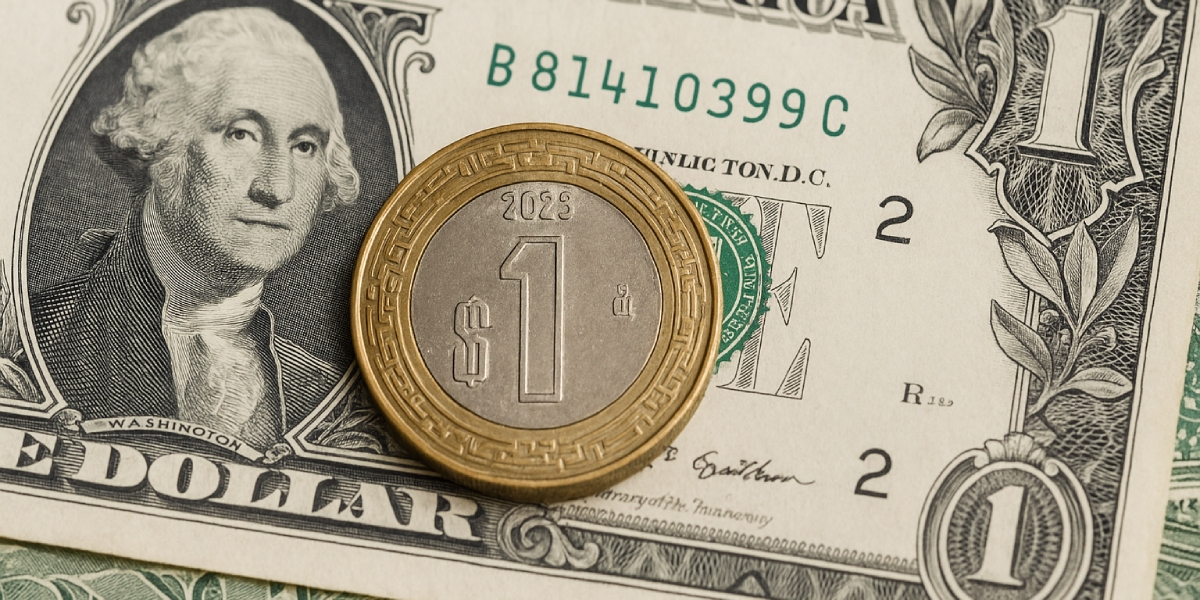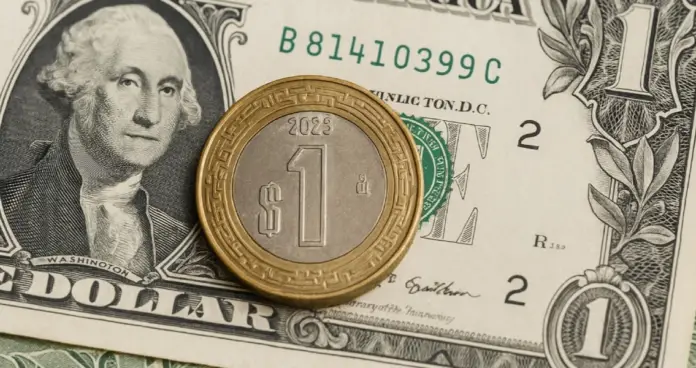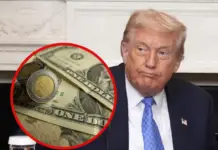The peso began the session with a depreciation of 0.39%, or 7.2 cents, trading at around 18.43 pesos per dollar. The exchange rate hit a low of 18.3382 and a high of 18.4671 pesos per dollar, declining for the third consecutive session and accumulating a depreciation of 0.80%, or 14.5 cents, over this period.
September is once again putting pressure on the Mexican peso against the dollar.
The peso’s depreciation occurred alongside a 0.35% strengthening of the dollar, according to the weighted index, which advanced for the third consecutive session and accumulated a gain of 0.94% over this period.
The dollar’s strengthening continues to be related to a correction of the losses from previous sessions. It’s worth remembering that on September 17, the dollar index hit a low not seen since March 1, 2022, accumulating a 9.17 percent decline for the year up to that session.
Furthermore, the dollar tends to strengthen in September due to the close of the fiscal year in the United States. Over the last 10 years, the Mexican peso has depreciated an average of 0.86% in September, and over the last 30 years (since the Mexican peso began floating freely), the average monthly depreciation has been 1.11%, losing ground against the dollar 63.3% of the time. According to the dollar-weighted index compiled by Bloomberg, the dollar gained an average of 0.84% in September over the last 10 years, making it the month with the largest gains of the year.
But despite losing ground over the last three days, the Mexican peso has appreciated 1.21% in September, and the dollar index has fallen 0.09% over the same period.
There is a possibility that the session will also see greater volatility in the financial markets due to triple witching, which involves the simultaneous expiration of stock options, stock index futures, and stock index option contracts. This also causes the dollar to strengthen and the peso to lose ground.
And regarding monetary policy, the Bank of Japan decided to keep the interest rate unchanged at 0.5% and announced that it will begin selling more than $508 billion in exchange-traded funds (ETFs), equivalent to 75 trillion yen. The sale will be at a rate of 620 billion yen per year. The decision to keep the rate unchanged was not unanimous, as there were two dissenting votes out of a total of nine in favor of raising the interest rate by 25 basis points. Therefore, the Japanese yen is one of the few currencies gaining ground at the start of the session. Yesterday, ahead of the monetary policy announcement, Japan’s 2-year bond rate rose to 0.917%, the highest since June 20, 2008.
The stock market, meanwhile, showed gains at the start of the session. In Asia, the Nikkei 225 lost 0.57%, due to the possibility that the Bank of Japan will raise interest rates in the coming months. However, the Hang Seng index in Hong Kong remained unchanged, and the CSI 300 index in Shanghai advanced 0.08%. In Europe, London’s FTSE 100 rose 0.16%, France’s CAC 40 gained 0.31%, and Germany’s DAX advanced 0.02%. In the United States, the Dow Jones Industrial Average rose 0.19%, the S&P 500 0.25%, and the Nasdaq 0.23%.
In the commodities market, gold opened the session trading at $3,647 per ounce, with a slight gain of 0.09%. The price of gold remains under upward pressure amid expectations that the Fed will cut its interest rate twice more, totaling 50 basis points. Furthermore, yesterday, Trump asked the Supreme Court to uphold his decision to fire Lisa Cook, rekindling doubts about the precedent this could set on the independence of the Federal Reserve. Meanwhile, WTI crude oil opened the session with a 0.47% drop, trading at $63.27 per barrel. Oil fell due to a cautious market in light of less positive expectations for demand, after the US EIA mentioned that there could be a short-term decline in crude demand.
So far this year, economic activity has grown at an average monthly rate of 0.16%, including data through August. Assuming that the economy grows at this pace in September (0.16% monthly), third-quarter GDP would show a quarterly contraction of 0.25%, annual growth of 0.05%, and cumulative growth for the year of 0.63%.
Second-quarter GDP figures, using an aggregate demand approach, showed that private consumption grew 1.22% quarterly, following two consecutive quarters of declines and the largest quarterly increase since the third quarter of 2023. Government consumption also grew 0.48% quarterly, accelerating slightly from 0.45% in the previous quarter.
Slight growth in investment was observed, as gross fixed capital formation advanced 0.18% quarterly, following the 4.05% drop in the previous quarter. Domestically, public sector investment contracted 1.55% quarterly, a smaller contraction than that recorded in the first quarter of 2025 (-8.17%). This marks six consecutive quarters of quarterly contractions in gross fixed capital formation of public origin. Meanwhile, private sector investment grew 0.34% quarterly, breaking a two-quarter streak of contraction. Finally, in the external sector, exports of goods and services grew 0.58% quarterly, slowing from 1.55% in the previous quarter and marking the lowest growth since the first quarter of 2024. Imports of goods and services increased 3.91% quarterly, their largest increase since the fourth quarter of 2020.
At an annual rate, private consumption grew 0.52% in the second quarter, following a contraction in the previous quarter. Government consumption, meanwhile, showed annual growth of 1.02%, while gross fixed capital formation contracted 5.90% annually, marking three consecutive quarters of decline. Within gross fixed capital formation, public investment contracted 19.72% annually, accumulating five months of declines. Private investment contracted 4.25% annually, falling for the third consecutive quarter. Finally, exports of goods and services grew 12.03% annually, while imports advanced 2.04%. This implies that, in the second quarter, most of the economic growth momentum was driven by exports, despite the protectionist policy in the United States, as a result of not all tariffs being fully enforced, and the significant growth in computer equipment exports.
According to original series, in the second quarter of 2025, private consumption accounted for 70.14% of GDP, increasing 0.16 percentage points compared to the previous quarter and representing the highest proportion since the fourth quarter of 2024. Government consumption, meanwhile, accounted for 11.06% of GDP, almost unchanged from the previous quarter. Gross fixed capital formation accounted for 22.70% of GDP, the lowest share since the fourth quarter of 2022. Exports of goods and services accounted for 41.68%, up from 41.50% in the first quarter of 2025, while imports accounted for 45.85%, up from 43.17% in the first quarter of 2025.
Money and Debt Markets
In the United States, the 10-year Treasury note rate rose 1.3 basis points to 4.12%.
Derivatives Market
To hedge against a depreciation of the peso beyond 20.00 pesos per dollar, a call option with an exercise date within one month has a premium of 0.59% and represents the right, but not the obligation, to buy dollars at the aforementioned level.
On the other hand, the interbank forward for sale is at 18.4556 at 1 month, 18.7544 at 6 months, and 19.1299 pesos per dollar at one year.

Source: realstatemarket




